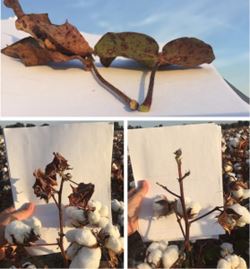Defoliation Strip Trial Ratings/Summary
DR. TYSON RAPER
JACKSON, TENN.
A few weeks ago two defoliation strip trials were established in West TN. One of these was placed in Crockett County and another was placed in Gibson County. After application, I returned to rate the treatments for defoliation, boll opening, and leaves stuck or ‘frozen’. Regrowth was not rated as little regrowth was noted in these fields. A couple of notable results from these trials are listed below. Keep in mind both fields experienced moderately warm, clear conditions following application.
• Finish versus Terminate versus ethephon: The addition of cyclanilide (additional active in Finish/Terminate not in ethephon) appeared to speed up the defoliation/opening processes in the days immediately following application. Slight increases in percent defoliation and percent open 10-14 days after application were noted in several treatments with cyclanilide-containing products. Both cyclanilide-containing products performed well and little difference was noted between the two.
• ‘Cutting’ Finish/Terminate with ethephon: A common practice by some, ‘cutting’ a full-rate of a cyclanilide-containing product with ethephon resulted in similar boll opening and defoliation to the full rate of the cyclanilide-containing products.
• Daze with and without Folex: Treatments with Daze (thidiazuron) plus a boll opener did not perform as well at defoliating or opening bolls as treatments containing Daze plus Folex (tribufos) plus a boll opener.
• PPOs in second shot: As expected, the two tested PPO herbicides singed remaining leaves and resulted in some shedding and some sticking but almost no green material remaining on plant.
It is likely that results from these strips may change substantially under cooler temperatures as the utility of hormonal based defoliants/openers begins to decline and the value of herbicidal-based defoliants increases. With the exception of the PPO herbicide containing treatments, there were only a few ‘stuck’ leaves in these trials. This is partially due to the generally low-rate nature of the treatments made in combination with environmental conditions which supported formation of abscission zones at the base of the petioles. The top image in the panel above displays an inactive abscission zone from a stuck leaf (left) compared to the active abscission zone on a leaf which would have likely shed in the days following the date of this image (right). Only slight pressure on the top of the leaf to the right was required to cause the leaf to shed. The green color at the base of the petiole is evidence that the applied treatment had caused enough injury and shifted the hormonal balance enough to begin (and nearly complete) the shedding process. Since this is a hormonal process, it will become more difficult to achieve the results pictured in the bottom left image of the panel above as temperatures begin to decline. With low 40s in the forecast for West Tenn. over the next 10 days, reaching application goals beyond desiccation may soon be impossible. ∆
DR. TYSON RAPER: Cotton & Small Grains Specialist, University of Tennessee
